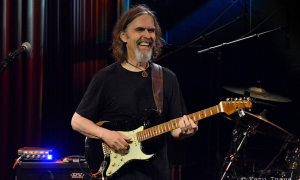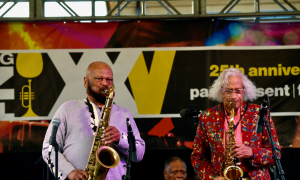Home » Jazz Articles » SoCal Jazz » The Monk'estra Trilogy: The Genius of John Beasley and T...
The Monk'estra Trilogy: The Genius of John Beasley and Thelonious Monk

Courtesy Eric Wolfinger
John is an amazing pianist, composer, and arranger. He is a brilliant and extremely creative musician with an extraordinary vision for any and all projects he encounters and embraces. John's creativity gave birth to this dynamic, adventurous, and simply wonderful concept.
—Jimmy Haslip
Pianist, composer, and arranger John Beasley grasped Monk's music at the ripe old age of eleven. Noteworthy, in as much as half the adult population at that time couldn't get their heads around the improvisational complexities and quirkiness of his compositions. With forty years of his own in the music world, and a near lifetime of absorbing Monk, Beasley opened up the time capsule. A miracle of two geniuses collided and Monk'estra was born. In 2013, the sixteen-piece Monk'estra band began their journey by rendering performance arts center audiences into jaw dropping speechless delight.
 Flashing to the present, the third album of the Monk'estra Trilogy (to date, we can only hope there is more to come), Monk'estra Plays Beasley (Mack Avenue Records, 2020) has been nominated for a Grammy in the category of Best Large Jazz Ensemble Album. The first two equally brilliant records, John Beasley Presents Monk'estra Volume 1 (Mack Avenue, 2016) and John Beasley Presents Monk'estra Volume 2 (Mack Avenue, 2017) were both also nominated for Best Large Jazz Ensemble Album. The much-deserved recognition will bring attention to these extraordinary illuminations of Monk's compositions and creativity. It's an injustice to any serious jazz listener for this music not to be gleaned in it's full glory. Am I able to support such bold proclamations? You bet.
Flashing to the present, the third album of the Monk'estra Trilogy (to date, we can only hope there is more to come), Monk'estra Plays Beasley (Mack Avenue Records, 2020) has been nominated for a Grammy in the category of Best Large Jazz Ensemble Album. The first two equally brilliant records, John Beasley Presents Monk'estra Volume 1 (Mack Avenue, 2016) and John Beasley Presents Monk'estra Volume 2 (Mack Avenue, 2017) were both also nominated for Best Large Jazz Ensemble Album. The much-deserved recognition will bring attention to these extraordinary illuminations of Monk's compositions and creativity. It's an injustice to any serious jazz listener for this music not to be gleaned in it's full glory. Am I able to support such bold proclamations? You bet. Firstly, I reviewed the current and frisky Monk'estra Plays Beasley earlier this month. I invite you to read about it here. Today I would like to address the two would be Grammy winners. Beasley was knowingly selective in his song choices and impressively pulled from seventeen different Monk albums over the course of the two records.
 In beginning this project, one can only imagine the level of seriousness and difficulty Beasley had in choosing which Monk tune to play first on Volume 1. First impressions and all that—-not that John Coltrane has anything to do with it. Alas, he eased us in with "Epistrophy," first recorded by Monk as the B side of the "In Walked Bud" single in 1948. The Monk song recognition is immediate, even if you didn't know what you were listening to. The inventions begin with guest Gary Burton playing a sonic vibes solo that leads into an understated big band celebration. Then the gloves come off. An eight-minute romp of "Skippy" Genius of Modern Music: Volume 2 (Blue Note, 1952) explodes on to the scene with big band fun and expressionism. Bob Sheppard ignites with an alto sax solo that is then matched by his own soprano solo. It never lets up as trumpeter Brian Swartz engages in a sweet solo, that is then followed by a tasty muted-horn solo from Bijon Watson. Now breathless, Gary Novak's Gene Krupa-esque soft segue to the finale comes just in a nick of time! The train is rolling now, and not about to slow down. In fact, "Oska T" Big Band and Quartet in Concert (Columbia. 1964), is presented as a runaway train. Dynamic in scope, we hear more substantial solos confronted with a modern big band mentality. Solo credits to trumpeters Swartz and Gabriel Johnson, as well as trombonist Francisco Torres.
In beginning this project, one can only imagine the level of seriousness and difficulty Beasley had in choosing which Monk tune to play first on Volume 1. First impressions and all that—-not that John Coltrane has anything to do with it. Alas, he eased us in with "Epistrophy," first recorded by Monk as the B side of the "In Walked Bud" single in 1948. The Monk song recognition is immediate, even if you didn't know what you were listening to. The inventions begin with guest Gary Burton playing a sonic vibes solo that leads into an understated big band celebration. Then the gloves come off. An eight-minute romp of "Skippy" Genius of Modern Music: Volume 2 (Blue Note, 1952) explodes on to the scene with big band fun and expressionism. Bob Sheppard ignites with an alto sax solo that is then matched by his own soprano solo. It never lets up as trumpeter Brian Swartz engages in a sweet solo, that is then followed by a tasty muted-horn solo from Bijon Watson. Now breathless, Gary Novak's Gene Krupa-esque soft segue to the finale comes just in a nick of time! The train is rolling now, and not about to slow down. In fact, "Oska T" Big Band and Quartet in Concert (Columbia. 1964), is presented as a runaway train. Dynamic in scope, we hear more substantial solos confronted with a modern big band mentality. Solo credits to trumpeters Swartz and Gabriel Johnson, as well as trombonist Francisco Torres. No more spoiler alerts (at least on Volume 1). I believe you get the idea. In all, nine Monk tunes, including the classic "Round Midnight," are brightly reimagined. A Gregoire Maret interpretation inside Beasley's arrangement of "Ask Me Now" Genius of Modern Music: Volume 1 (Blue Note, 1952), Gallop's Gallup" Live At The It Club (Columbia, 1982), recorded in 1964, "Coming on the Hudson" Thelonious In Action: Recorded At The Five Spot Café (Riverside, 1958), a rip roaring "Little Rootie Tootie" Thelonious Monk Trio (Prestige, 1954) and a run on "Monk's Progressions."
 Volume 2 opens with the daring confidence of Beasley, emulating that of Monk. Monk took risks. He didn't care what you thought. He wasn't trying to impress anyone. Not fans or the critics. He played what was in his head and in his heart. A true artist. Rap meets Monk on the first song of the album. A rousing take on "Brake's Sakes" It's Monk Time (Columbia, 1964). This poetry/rap was powerful and pulled no punches in stating and lamenting the many problems we currently face in this world. It was encased, of course, in all the glory of big band. A song written for his wife, "Crepuscule with Nellie" Monk's Music (Riverside, 1957), is the epitome of fun and quirkiness embellished by Beasley with broad strokes and elongated stops and starts. Midway, it was as if violinist Stephane Grappelli had emerged from the past and eloquently shaded the journey. "Evidence" Misterioso (Riverside, 1958), yet another classic, is given perhaps even more open space than the original, soon filled with finger poppin' bass and drums of equal measure. It paved a groove latched onto with big band magnitude and a high-octane trombone solo.
Volume 2 opens with the daring confidence of Beasley, emulating that of Monk. Monk took risks. He didn't care what you thought. He wasn't trying to impress anyone. Not fans or the critics. He played what was in his head and in his heart. A true artist. Rap meets Monk on the first song of the album. A rousing take on "Brake's Sakes" It's Monk Time (Columbia, 1964). This poetry/rap was powerful and pulled no punches in stating and lamenting the many problems we currently face in this world. It was encased, of course, in all the glory of big band. A song written for his wife, "Crepuscule with Nellie" Monk's Music (Riverside, 1957), is the epitome of fun and quirkiness embellished by Beasley with broad strokes and elongated stops and starts. Midway, it was as if violinist Stephane Grappelli had emerged from the past and eloquently shaded the journey. "Evidence" Misterioso (Riverside, 1958), yet another classic, is given perhaps even more open space than the original, soon filled with finger poppin' bass and drums of equal measure. It paved a groove latched onto with big band magnitude and a high-octane trombone solo. Superbly sequenced, Beasley's Volume 2 also delights with reincarnations of Monk's "Played Twice" 5 By Monk By 5 (Riverside, 1959), "Ugly Beauty" Underground (Columbia, 1968), "Pannonia" Brilliant Corners (Riverside, 1957), "I Mean You" Art Blakey's Jazz Messengers with Thelonious Monk (Atlantic, 1958), "Light Blue"Thelonious In Action: Recorded At The Five Spot Café (Riverside, 1958), "Ruby My Dear Thelonious Monk with Coltrane (Jazzland, 1961), "Criss Cross" Criss Cross (Columbia, 1963), and "Work" Thelonious Monk and Sonny Rollins (Prestige, 1956).
The heart pumping sounds of big band jazz ascended on the world in the late to mid twentieth century. Joyous with a big beat and big horns, dancing and swinging erupted at a feverish pitch. The 1950's saw jazz turn to smaller ensembles. What was lost in power was gained in improvisation, individualized soloing, and intelligent conversations between musicians. Merging the two is complicated. Often you get one genre followed by the other, back to the other, etc. That's ping pong, not an integration of sounds. Monk'estra is more of an intellectual chess match. Beasley manages to keep all of Monk's stylings, inflections, melodies, individualities, and, has a field day with the intangible quirkiness. Monk's innate sense of swing is embodied throughout. It's all wrapped and intertwined within the scope of a pulsating big band. The arrangements on this three-part masterpiece are a road map of genius. Although the concepts and ideology are dense, he never forgets that music should be fun. Nor does he linger. Changing phrases darting in and out, all expanding on the vision, off-beat rhythms, and dissonance of Monk, brilliantly propel the Monk'estra Trilogy to epic proportions. Talk to musicians or composers in the know, and they will tell you that Beasley is king of the charts. It's about time we get John Beasley a crown, or better yet, a Grammy.
< Previous
Thelonious Monk: An Alternative Top T...
Next >
In Fonk We Trust
Comments
Tags
For the Love of Jazz
 All About Jazz has been a pillar of jazz since 1995, championing it as an art form and, more importantly, supporting the musicians who create it. Our enduring commitment has made "AAJ" one of the most culturally important websites of its kind, read by hundreds of thousands of fans, musicians and industry figures every month.
All About Jazz has been a pillar of jazz since 1995, championing it as an art form and, more importantly, supporting the musicians who create it. Our enduring commitment has made "AAJ" one of the most culturally important websites of its kind, read by hundreds of thousands of fans, musicians and industry figures every month.
























